
In military organizations, a colour guard is a detachment of soldiers assigned to the protection of regimental colours and the national flag. This duty is highly prestigious, and the military colour is generally carried by a young officer (ensign), while experienced non-commissioned officers are assigned to the protection of the national flag. These non-commissioned officers, accompanied in several countries by warrant officers, can be ceremonially armed with either sabres or rifles to protect the colour. Colour guards are generally dismounted, but there are also mounted colour guard formations as well.
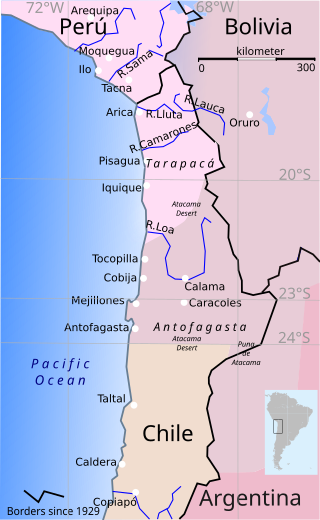
The War of the Pacific, also known as the Nitrate War and by multiple other names, was a war between Chile and a Bolivian–Peruvian alliance from 1879 to 1884. Fought over Chilean claims on coastal Bolivian territory in the Atacama Desert, the war ended with victory for Chile, which gained a significant amount of resource-rich territory from Peru and Bolivia.

In military organizations, the practice of carrying colours, standards, flags, or guidons, both to act as a rallying point for troops and to mark the location of the commander, is thought to have originated in Ancient Egypt some 5,000 years ago. The Roman Empire also made battle standards reading SPQR a part of their vast armies. It was formalized in the armies of Europe in the High Middle Ages, with standards being emblazoned with the commander's coat of arms.

The following is a list of historical military colours, standards and guidons in different countries that do not exist today.
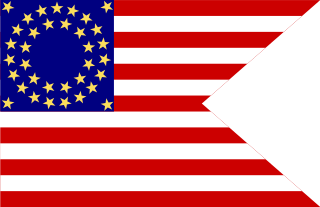
In the United States Armed Forces, a guidon is a military standard or flag that company/battery/troop or platoon-sized detachments carry to signify their unit designation and branch/corps affiliation or the title of the individual who carries it. A basic guidon can be rectangular, but sometimes has a triangular portion removed from the fly.

A battle honour is an award of a right by a government or sovereign to a military unit to emblazon the name of a battle or operation on its flags ("colours"), uniforms or other accessories where ornamentation is possible.

The Regulation Colours are the standard colours used in the armed forces of the countries of the Commonwealth of Nations.
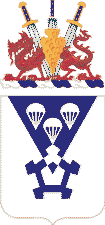
The 503rd Infantry Regiment, formerly the 503rd Parachute Infantry Regiment and the 503rd Airborne Infantry Regiment, is an airborne infantry regiment of the United States Army. The regiment served as an independent regiment in the Pacific War during World War II; at Fort Campbell, Kentucky; in Okinawa, Japan; and in Germany. Regimental elements have been assigned to the 2nd Infantry Division, the 11th Airborne Division, the 24th Infantry Division, 25th Infantry Division, the 82nd Airborne Division, 101st Airborne Division, and the 173rd Airborne Brigade Combat Team. Regimental elements have participated in campaigns in the Vietnam War, Operation Enduring Freedom–Afghanistan, and Operation Iraqi Freedom. The regiment claims 15 Medal of Honor recipients: two from World War II, ten from Vietnam, and three from Afghanistan. A parent regiment under the U.S. Army Regimental System. The regiment's 1st and 2nd Battalions are active, assigned to the 173rd Airborne Brigade, based at Caserma Ederle, Vicenza, Italy. The 3rd and 4th Battalions as well as Companies E, F, G, H, and I have been inactived.

The Queen's York Rangers (RCAC) is a Canadian Army Primary Reserve Royal Canadian Armoured Corps regiment based in Toronto and Aurora. The regiment is part of 4th Canadian Division's 32 Canadian Brigade Group. The regiment consists of one cavalry squadron, as well as the Headquarters and Training Squadron. The regimental family also includes The Queen's York Rangers Band (volunteer), along with two Royal Canadian Army Cadet corps and a Royal Canadian Air Cadet squadron. The unit mottos are pristinae virtutis memor – 'remembering their glories in former days' – and celer et audax – 'swift and bold'. Among its own members and those of other regiments, the unit is referred to as the Rangers. The name is abbreviated as QY Rang, and sometimes pronounced KWY-rang.
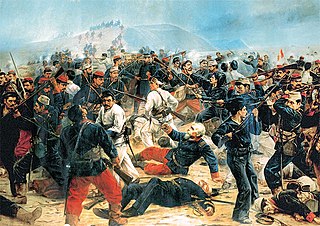
The Battle of Arica, also known as Assault and Capture of Cape Arica, was a battle in the War of the Pacific. It was fought on 7 June 1880, between the forces of Chile and Peru.

The Battle of San Francisco, also known as the Battle of Dolores, was a major battle in the Tarapacá Campaign of the War of the Pacific, fought on November 19, 1879, in the Peruvian department of Tarapacá. A Chilean army under Colonel Emilio Sotomayor had moved via Dolores rail road deep into the desert and was encamped at San Francisco Saltpeter Office, about 30 kilometers south east of the port of Pisagua. Allied forces under General Juan Buendía launched an attack on Sotomayor's army. At the beginning, Bolivian General Carlos de Villegas pressed the attack over a poorly defended battery right in the Chilean centre and almost succeeded. Only the arrival of infantry support allowed Colonel José Domingo Amunátegui to hold the position.
The Combat Arms Regimental System (CARS), was the method of assigning unit designations to units of some of the combat arms branches of the United States Army, including Infantry, Special Forces, Field Artillery, and Armor, from 1957 to 1981. Air Defense Artillery was added in 1968.

Hilarión Daza was a Bolivian military officer who served as the 19th president of Bolivia from 1876 to 1879. During his presidency, the infamous War of the Pacific started, a conflict which proved to be devastating for Bolivia.

The Battle of Tacna, also known as the Battle of the Peak of the Alliance, effectively destroyed the Peru-Bolivian alliance against Chile, forged by a secret treaty signed in 1873. On May 26, 1880, the Chilean Northern Operations Army led by General Manuel Baquedano González, conclusively defeated the combined armies of Peru and Bolivia commanded by Bolivian President, General Narciso Campero. The battle took place at the Inti Urqu (Intiorko) hill plateau, a few miles north of the Peruvian city of Tacna. As a result, Bolivia was knocked out of the war, leaving Peru to fight the rest of the war alone. Also, this victory consolidated the Chilean domain over the Tarapacá Department. The territory was definitively annexed to Chile after the signing of the Tratado de Ancón, in 1884, which ended the war. Tacna itself remained under Chilean control until 1929.
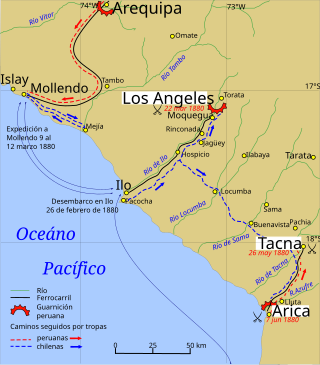
The Tacna and Arica campaign is known as the stage of the War of the Pacific after the Chilean conquest of the Peruvian department of Tarapacá, ending with Chilean domination of the Moquegua department in southern Peru. During this campaign Bolivia retired from the war after the Battle of Tacna, and Peru lost the port of Arica. Also, Manuel Baquedano assumed command as the new Commander in Chief of the Chilean Army, and the Allied Presidents were thrown out of office and replaced by Nicolas de Pierola in Peru and General Narciso Campero in Bolivia.

After the naval campaign of the War of the Pacific was resolved, the Chilean terrestrial invasion began.

The Infantry Branch is a branch of the United States Army first established in 1775.

The Tarapacá campaign was a short stage of the War of the Pacific in the last months of 1879, after the Chileans won definitive naval superiority at Angamos. It took its name from the region where it was fought.

The Presentation of Colours is a military ceremony that marks an anniversary or significant event in the history of a particular regiment or similar military unit. This involves the presentation of a new version of the regimental colour to a regiment or equivalent formation in their respective armed forces service branch. This is a traditional ceremony that was pioneered by the British Armed Forces, and is today used in most Commonwealth countries.

The President's Colour Award is the highest honour that can be bestowed upon any military unit of India. It is also known as Nishaan, which is an emblem that is worn by all unit officers on the left-hand sleeve of their uniform.





















